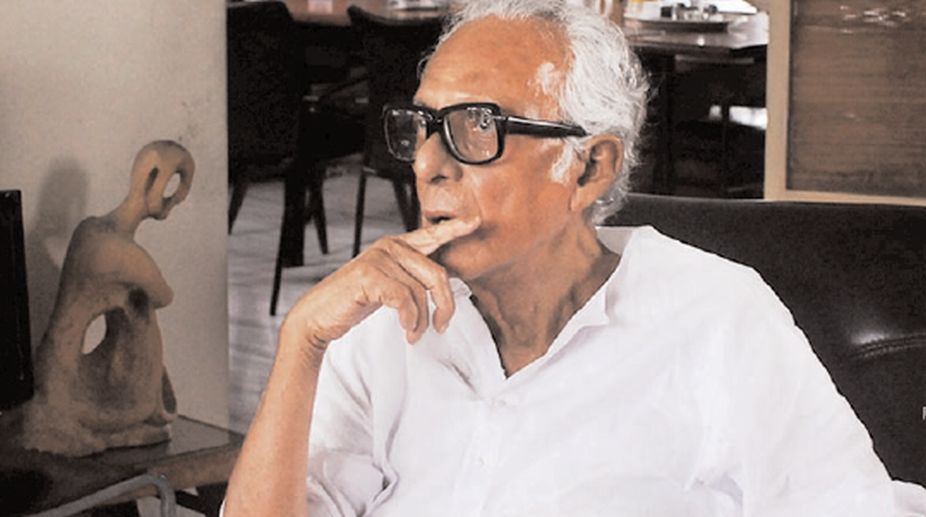None of films made by Mrinal Sen would lend themselves to a strident feminist reading. The gender aspect in them is incidental, woven into the script and never overloaded with messages.
Yet, one discerns an element of respect for women in every film he has directed, be it the highly criticised Oka Oorie Katha(1977) based on Munshi Premchand’s classic story Kafan, or the intriguing Ek Din Pratidin (1979) where the woman protagonist around whom the film revolves is absent throughout the cinematic space but leaves her mark on the annals of time.
Advertisement
Pratinidhi(1964) of which not a single print remains, is an under-rated film. It unfolds an emotionally disturbing story about how the little son from a previous marriage unwittingly spoils his mother’s second chance at marital happiness when he refuses to accept the husband as his mother’s life partner.
The newly married couple (portrayed movingly by Sabitri Chatterjee and Soumitra Chatterjee) find it difficult to sleep together because of the little boy. Finding her immediate circumstances going out of control, the young woman commits suicide. Her death brings the stepfather and stepson close.
This film carries subtle hints about how Mrinal Sen was slowly and steadily beginning to reveal empathy for women. The common point is that instead of taking sides, Sen throws questions for his viewers to draw answers from. Neither does he offer readymade solutions nor is he ever judgemental about his characters and their denouement.
Akaler Sandhane (In Search of Famine, 1980) is perhaps the only selfreflexive film where Sen deals with a film-within-a-film probably to point an accusing finger at the fraternity, which includes himself.
It opens and closes with a voiceover mouthing lines without tone or pitch. The story is about a group of film people travelling in a bus towards a village to location shoot a film based on the Bengal famine of 1943. Smita Patil who is the leading lady of the famine film, plays herself.
There is a blurring between the past and present with the narrative zeroing in on Durga, a local girl roped in to do a role that is almost identical with her real life situation. Her husband, baby and she are on the point of starvation in real life.
She is asked to play this same role for the film and since she has never faced a camera before, the difference between the real and the reel fades as she picks up the baby and is about to throw it down because she cannot feed it.
The voice-over at the end of the film says that no one saw Durga ever again. The message the film tries to put forth is that Bengal is still famine-stricken in some pockets where the “famine” is man-made and not due to natural circumstances.
“The women in Mrinal Sen ’s life make a world of difference to his films. Foremost among them is his wife, Geeta, who has lent to his recent films a gentle humanity and grace that his socially committed but somewhat meritorious work seemed to lack. In his latest Kharij (Rejected), her appearance is brief; yet she provides a leavening that softens something of the film’s austerity,” wrote Chidananda Dasgupta in his article. Mrinal Sen allows the audience to draw its own conclusions in Kharij.
Khandhar(1983) is a film that was restored and re-screened at Cannes in 2010. Though Khandhar leaves the first impression of a “constructed” love story gone wrong, in reality, it is poles apart from any kind of love story. It is about three young men who arrive at the ruins of a dilapidated mansion, a little distance away from Calcutta on holiday. One of them is a photographer who is surprised and intrigued by the original inhabitants of the mansion comprising a blind and bedridden old woman (Gita Sen) and her young, marriageable daughter Jamini (Shabana Azmi).
These two women are as if, an integral part of the ruins themselves, because they live distanced from the mainstream. The daughter asks the photographer to pretend to her blind and sick mother that he is the fiancé who promised to come back and marry her. He does but this does not lead to anything at all. In fact, it leaves Jamini with a small ray of hope that perhaps, there still might be light at the end of the dark tunnel.
The three young men leave and one finds the photographer pinning some beautiful portraits of Jamini alongside the portraits of professional, stylishly clad models that form part of his studio in the city. The photographer develops his prints in his room in Calcutta.
The last picture he develops is of the well balanced image of a Bengali woman among the ruins of an old mansion, with moss and weeds threatening to overshadow brick and mortar. Like any city-bred professional looking for subjects to photograph, he has turned Jamini into one more model for his photographic adventure, never mind if it is distanced from his usual oeuvre.
Ekdin Pratidin, based on a story by Amalendu Chakravarty entitled Abirata Chenamukh (Known faces, endlessly) describes the happenings of a day and night in a lower middle- class complex of flats where everyone knows each other and there is little of the thing called privacy. In one of those flats, a daughter who also happens to be the sole earning member of the family fails to return home.
.“It is somewhat in the manner of Henrik Ibsen, who begins with a big event that sparks off many things. I try to pick out small things from everyday happenings, from daily life, and try to give them shape, lead them to a point. The characters undergo a metamorphosis and enter into new relationships in the process, with an emergence of new values, which is perhaps one of the hopes for survival,” says Sen.
Ek Din Pratidin is one of the most poignant films directed by Mrinal Sen and one that he produced himself. It has an unhurried pace that unfolds, layer by slow and detailed layer, the position of women in Indian society in general and of working women in middle- class families in particular.
The entire unfolding of the story takes place in Calcutta with the dilapidated housing complex in which Chinu and her family live taking up a major slice of the space. The events begin and end within the span of a night, from the time Chinu fails to return from work, till the next morning when she finally comes home.
Like Nita of Meghe Dhaka Tara, Chinu is a microcosm of the working woman in a middle-class Bengali family where she is the sole earning member. But unlike Nita, Chinu is no child of Partition. Nor is she a victim of consumption the way Nita is. She is not destined to die. But can her life be really called living? She is part of Calcutta in the late Seventies, coinciding with the year of the film though this is not mentioned anywhere.
The geographical censorship of a young Bengali woman is presented through Chinu. There is a reference about how the parents forced Chinu to give up her boyfriend, probably a political extremist, simply because they felt the groom did not suit their middle-class ideas of a son-in-law. Chinu’s own feelings on the issue were never considered.
Geographical censorship extends to social and emotional censorship and it is understood that Chinu will probably never be able to marry, burdened as she is, with the responsibility of a relatively big family. That the said boy is later killed in an encounter with the police reinforces the reality of Chinu remaining a spinster.
Chinu’s failure to return that night, sets off a chain of incidents and reactions among the neighbours residing in the other flats, among Chinu’s family members and finally, between Minu, Chinu’s younger sister, and her mother. Chinu’s absence from the narrative space of the film shows how important her presence is for first, the upkeep of her family, hinted at through dialogues of the present members, and second, the reputation of the family.
Chinu herself has internalised this ethical question set in a patriarchal mould to some extent. This is evident when she asks Minu why she has not been asked the reason for her not coming home the previous night. It could be interpreted as a rhetorical question that does not need an answer — no one has dared to ask her because she is the sole earning member of the family and they are afraid to hear answers that might be uncomfortable to their present state of living and livelihood.
The double standards of patriarchy are defined sharply within the contradiction that Chinu represents. On one hand, the family almost pushes her into the market place. On the other, it places severe restrictions on the hours she can be away from home. They allow her to work because it provides financial support. Yet, they do not hesitate to draw subjective value judgements on her absence.











